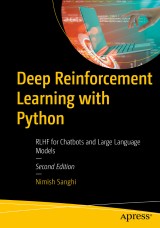Details

Deep Reinforcement Learning with Python
RLHF for Chatbots and Large Language ModelsSecond Edition
|
CHF 71.00 |
|
| Verlag: | Apress |
| Format: | |
| Veröffentl.: | 13.07.2024 |
| ISBN/EAN: | 9798868802737 |
| Sprache: | englisch |
| Anzahl Seiten: | 450 |
Dieses eBook enthält ein Wasserzeichen.
Beschreibungen
<div><p>Gain a theoretical understanding to the most popular libraries in deep reinforcement learning (deep RL). This new edition focuses on the latest advances in deep RL using a learn-by-coding approach, allowing readers to assimilate and replicate the latest research in this field. </p><p>New agent environments ranging from games, and robotics to finance are explained to help you try different ways to apply reinforcement learning. A chapter on multi-agent reinforcement learning covers how multiple agents compete, while another chapter focuses on the widely used deep RL algorithm, proximal policy optimization (PPO). You'll see how reinforcement learning with human feedback (RLHF) has been used by chatbots, built using Large Language Models, e.g. ChatGPT to improve conversational capabilities.</p><p>You'll also review the steps for using the code on multiple cloud systems and deploying models on platforms such as Hugging Face Hub. The code is in Jupyter Notebook, which canbe run on Google Colab, and other similar deep learning cloud platforms, allowing you to tailor the code to your own needs. </p><p>Whether it’s for applications in gaming, robotics, or Generative AI, <i>Deep Reinforcement Learning with Python</i> will help keep you ahead of the curve.</p><div><br></div></div><div><b>What You'll Learn</b><br></div><div><p></p><ul><li>Explore Python-based RL libraries, including StableBaselines3 and CleanRL </li><li>Work with diverse RL environments like Gymnasium, Pybullet, and Unity ML</li><li>Understand instruction finetuning of Large Language Models using RLHF and PPO</li><li>Study training and optimization techniques using HuggingFace, Weights and Biases, and Optuna </li></ul><ul> </ul><div></div><p></p><p><b>Who This Book Is For</b></p><p>Software engineers and machine learning developers eager to sharpen their understanding of deep RL and acquire practical skills in implementing RL algorithms fromscratch. <br></p></div><div><br></div>
<p>Chapter 1: Introduction to Reinforcement Learning.- Chapter 2: The Foundation – Markov Decision Processes.- Chapter 3: Model Based Approaches.- Chapter 4: Model Free Approaches.- Chapter 5: Function Approximation and Deep Reinforcement Learning.- Chapter 6: Deep Q-Learning (DQN).- Chapter 7: Improvements to DQN.- Chapter 8: Policy Gradient Algorithms.- Chapter 9: Combining Policy Gradient and Q-Learning.- Chapter 10: Integrated Planning and Learning.- Chapter 11: Proximal Policy Optimization (PPO) and RLHF.- Chapter 12: Introduction to Multi Agent RL (MARL).- Chapter 13: Additional Topics and Recent Advances.<b></b></p><br><p></p>
<p>Nimish is a seasoned entrepreneur and an angel investor, with a rich portfolio of tech ventures in SaaS Software and Automation with AI across India, the US and Singapore. He has over 30 years of work experience. Nimish ventured into entrepreneurship in 2006 after holding leadership roles at global corporations like PwC, IBM, and Oracle.</p><p> </p><p>Nimish holds an MBA from Indian Institute of Management, Ahmedabad, India (IIMA), and a Bachelor of Technology in Electrical Engineering from Indian Institute of Technology, Kanpur, India (IITK). </p><br>
<p>Gain a theoretical understanding of the most popular libraries in deep reinforcement learning (deep RL). This new edition focuses on the latest advances in deep RL using a learn-by-coding approach, allowing readers to assimilate and replicate the latest research in this field.</p>
<p>New agent environments ranging from games, and robotics to finance are explained to help you try different ways to apply reinforcement learning. A chapter on multi-agent reinforcement learning (MARL) covers how multiple agents can be trained, while another chapter focuses on the widely used deep RL algorithm, proximal policy optimization (PPO). You’ll see how reinforcement learning with human feedback (RLHF) has been used to fine-tune Large Language Models (LLMs) to chat and follow instructions. An example of this is the OpenAI ChatGPT offering human like conversational capabilities.</p>
<p>You’ll also review the steps for using the code on multiple cloud systems and deploying models on platforms such as Hugging Face Hub. The code is in Jupyter Notebook, which can be run on Google Colab, and other similar deep learning cloud platforms, allowing you to tailor the code to your own needs.</p>
<p>Whether it’s for applications in gaming, robotics, or Generative AI, Deep Reinforcement Learning with Python will help keep you ahead of the curve.</p>
<p>New agent environments ranging from games, and robotics to finance are explained to help you try different ways to apply reinforcement learning. A chapter on multi-agent reinforcement learning (MARL) covers how multiple agents can be trained, while another chapter focuses on the widely used deep RL algorithm, proximal policy optimization (PPO). You’ll see how reinforcement learning with human feedback (RLHF) has been used to fine-tune Large Language Models (LLMs) to chat and follow instructions. An example of this is the OpenAI ChatGPT offering human like conversational capabilities.</p>
<p>You’ll also review the steps for using the code on multiple cloud systems and deploying models on platforms such as Hugging Face Hub. The code is in Jupyter Notebook, which can be run on Google Colab, and other similar deep learning cloud platforms, allowing you to tailor the code to your own needs.</p>
<p>Whether it’s for applications in gaming, robotics, or Generative AI, Deep Reinforcement Learning with Python will help keep you ahead of the curve.</p>
Explains deep reinforcement learning implementation using TensorFlow, PyTorch and OpenAI Gym Comprehensive coverage on fine-tuning Large Language Models using RLHF with complete code examples Every concept is explained with the help of a working code which can run with minimal effort


















